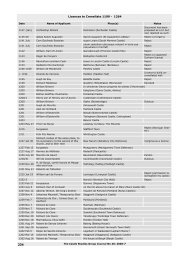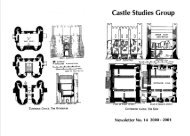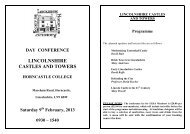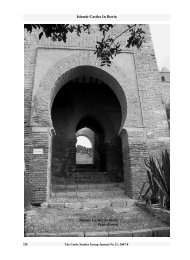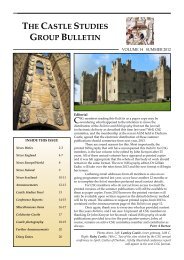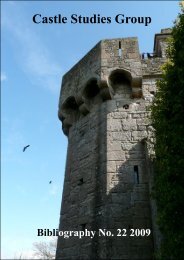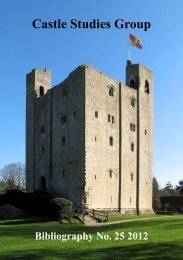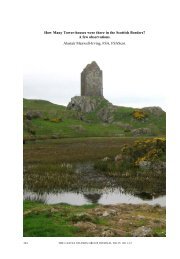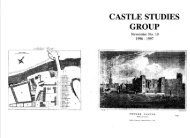Machicolation: some postscripts. - Castle Studies Group
Machicolation: some postscripts. - Castle Studies Group
Machicolation: some postscripts. - Castle Studies Group
Create successful ePaper yourself
Turn your PDF publications into a flip-book with our unique Google optimized e-Paper software.
<strong>Machicolation</strong>: <strong>some</strong> <strong>postscripts</strong>.this arrangement: there is also at least onestraight run of the qasba wall designedwith both similar machicolation and gunports.By this date, it could be argued thatthe use of cannon by attackers meant that tocover of the base of the wall against ramsor escalade had become less important. AtAzemmour, this realisation has had an effecton design. Fire from openings such asthese could interdict besiegers’ cannon andtroops approaching any breach in the wallopened by their cannon.The form of machicolation foundhere - chutes for handguns diagonallypiercing the thickness of a wall – is alsofound three hundred or so years later on theso-called Machicouli Tower at theMarienburg Fortress at Würzburg, 13where working embrasures are placed beneathfalse bracketed machicolations apparentlyused to suggest historical authorityand power and to introduce as degree ofdecoration (Fig. 11). Is this use of falsemachicolation a hangover from late mediaevaltimes, or a precursor of the Romanticnineteenth century view of fortification,when German military architecture adoptedpseudo-mediaeval motifs in a big way?Finally, a look at the Villa Giustinianat Roncade in the Veneto. 14 Theword “villa” is significant, because here weseem to have an authentic case of machicolationunquestionably used for only showand possibly to suggest a seigneurial authority,although work done with surprisingthoroughness (Figs 12, 13). The villa complexwas apparently built over a protractedperiod, between the early 1510s and itscompletion in about 1529. It consists of acompletely unfortified house, fashionablyRenaissance in style, surrounded by whatappears to be a defensible wall with rectangularcorner towers and a gateway withtwin round towers equipped with machicolation,the whole enceinte finished off withswallow-tailed Ghibelline merlons. Theform is known as a castello in the regionand dates from at least the early fifteenthcentury and originally effectively fortified.The arrangements at the Villa Giustinianseem to suggest defence against more thanwolves and roaming footpads, but in therear wall of the enclosure is an openinginto a garden, completely without a gate ofany kind (at least by 1536, when a map wasdrawn) moreover the main gate is a triumphalarch and lacks most of the devices ofa fortified gateway. The front wall has nowallwalk at all and the side walls are theouter walls of farm buildings.It hardly seems that this is a seriouslydefensible complex at all, and indeed,in Tuscany, for example, similarcomplexes of villa and farm had been builtwith only the slightest token show of castle-likedefensibility. Lorenzo de’ Medici’sVilla Poggio a Caiano dating from about1485, has what are no less than summerhousesas its corner “towers” and a palacedoorway for its gate, while maintaining theappearance of an enclosure. 15Although probably not meant tobe used in anger, the defensive elements ofthe towers at Roncade are designed withcare and are convincing. You could drop orshoot through the machicolation openingsif you wanted to and the brackets are boldand business-like, resembling Tuscanwork of the 1480s, for instance. They arenot at all like the obviously decorativeversions at the Castel Nuovo in Naples, forinstance. Then we notice that the gatehousetowers with their machicolation arevirtually reproduced in miniature by thechimneys of the villa and the drawing of1536 shows <strong>some</strong>thing very similar. 16 Thegeneral profile of the chimneys is again thetypical Venetian type. There may havebeen restoration, but it does look as if thiseffect was always intended. There is <strong>some</strong>thingvery like a joke here and moreover asuggestion that forms are being used playfully,perhaps as fashion items.The <strong>Castle</strong> <strong>Studies</strong> <strong>Group</strong> Journal No 24: 2010-11 224



